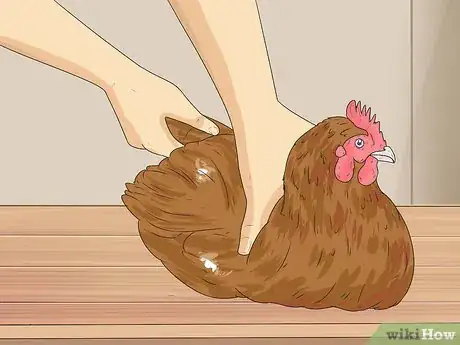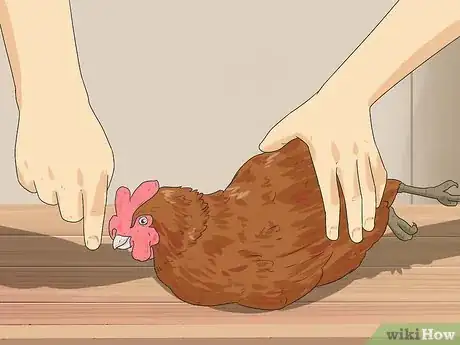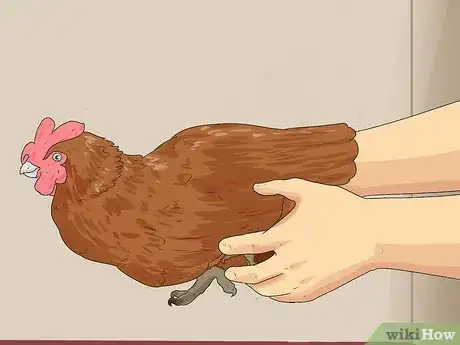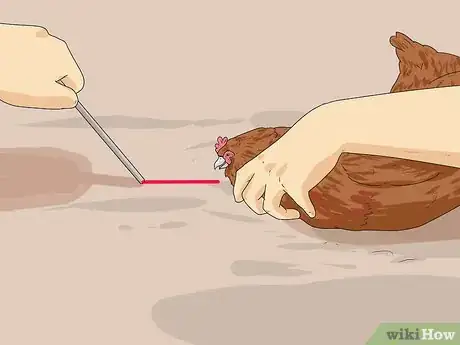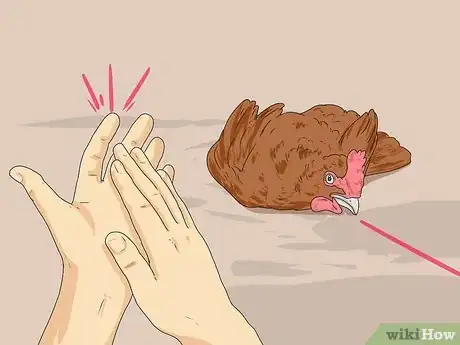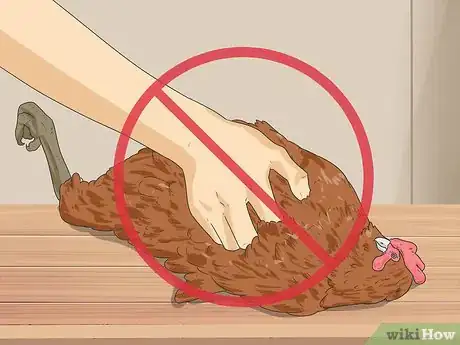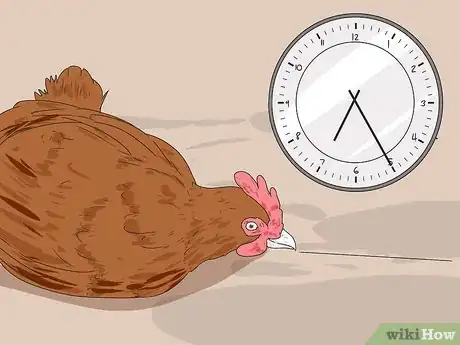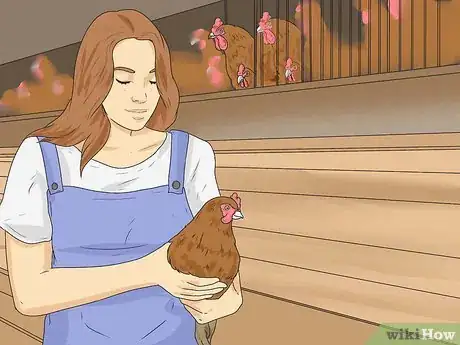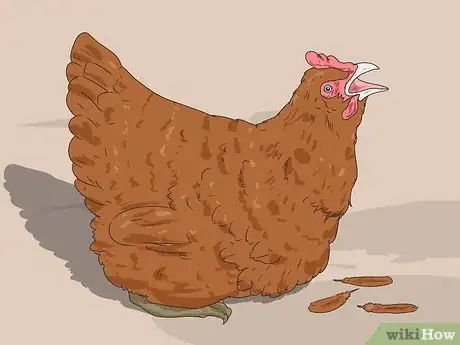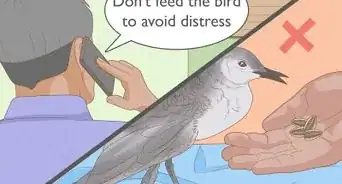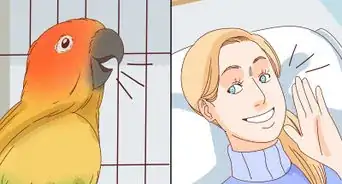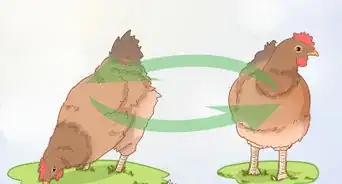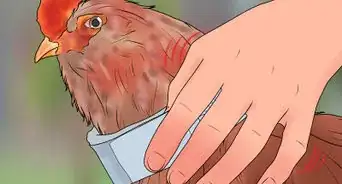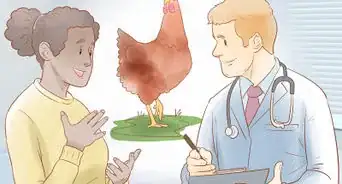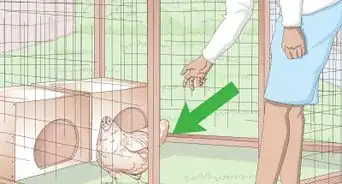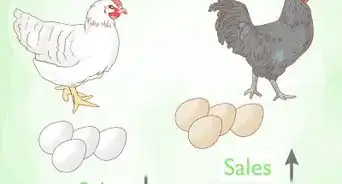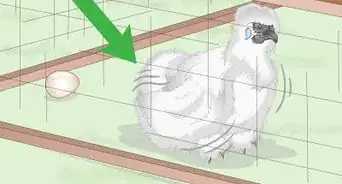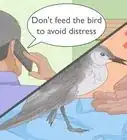wikiHow is a “wiki,” similar to Wikipedia, which means that many of our articles are co-written by multiple authors. To create this article, 34 people, some anonymous, worked to edit and improve it over time.
This article has been viewed 180,863 times.
Learn more...
Anyone who's spent a lot of time on a farm with chickens is probably familiar with this trick. Those who've never heard of this will be amazed to see a chicken lie perfectly still after these instructions are followed. Biologists think that fear causes this "hypnosis," which may be an attempt to "play dead" to fool predators.
Steps
Hypnotizing the Chicken
-
1Hold the chicken down on a flat surface. Hold the chicken with one hand supporting the breast. Place it down so that its breast is carrying its weight and rests on the ground. Continue to hold its feet so the grand experiment can continue.
- You can place the chicken on its breast instead. Press gently down on its back, and gently move its legs back if it tries to stand up.[1]
-
2Wiggle your finger. Hold the bird down gently with one hand. Put one finger on your other hand just in front of its beak tip, without touching it. Move the finger backward to about 4 inches (10 cm) away, then back again.[2] Repeat until the chicken stops moving or squawking.Advertisement
-
3Let go of its legs. The chicken should be "hypnotized" and cease to struggle. It will lie there for anywhere from 30 seconds to several minutes.
-
4Draw a line in front of its beak instead. If the chicken wasn't hypnotized, try this alternative. Using chalk, a stick, or your finger, draw a line on the ground 12" (30 cm) long. Start near the chicken's beak and draw the line slowly outward, in front of its head.
- Some people use a horizontal line in front of the chicken instead.[3] Are chickens afraid of lines? Is there any reason this would work better than wiggling your fingers? Great minds still search for an answer.
-
5Wake it up by clapping. Be nice to your feathered friend and let it get back to its business. Clap your hands or give it a gentle shove until it jumps up and walks away.
Reducing Stress in the Chicken
-
1Understand the hypnotic effect. Researchers call this effect "tonic immobility." When a chicken or another animal with this tendency becomes frightened, its heart rate lowers and it stops moving.[4] This may be an attempt to play dead, discouraging predators that prefer live prey. Unlike an opossum, the chicken gives an unconvincing act, as it continues to blink and breathe in an obvious way.
-
2Keep the chicken upright or on its side. While it's not uncommon to transport a chicken by its feet, this upside-down hold risks breaking the chicken's hip. Hypnosis techniques that involve laying a chicken on its back may "succeed" by cutting off its air supply. This can cause the chicken significant discomfort, leading to fainting or even, rarely, death.[5]
-
3Keep hypnosis short and infrequent. It's not completely clear how much stress this hypnosis causes. Even if it does, the chicken shouldn't suffer as long as you let it go soon afterward. Hours of stress, or regular exposure to stressful situations, can cause serious health problems.
-
4Get your chickens used to humans and novelty. Chickens cope with stress better if they are used to contact with humans. Even prolonged eye contact seems to have an effect. Living in stimulating environments with new objects may also help. Hens raise in battery cages stay "hypnotized" longer, possibly because of greater fear.[6]
-
5Watch for signs of stress. Abnormal feathering, constant preening, or delays in egg-laying are all signs of a stressed chicken.[7] While hypnotizing is unlikely to cause serious harm, any type of stress is more damaging to a chicken in this state.
Community Q&A
-
QuestionWhen will anyone ever need to do this?
 Amy HarrisonTop AnswererHypnotizing a chicken isn't a need-to-know thing, but it is a fun thing to try out.
Amy HarrisonTop AnswererHypnotizing a chicken isn't a need-to-know thing, but it is a fun thing to try out. -
QuestionHow can I open my chicken's beak?
 Amy HarrisonTop AnswererYou can try to get your finger inside, but avoid prying the beak open as it's highly uncomfortable for the chicken.
Amy HarrisonTop AnswererYou can try to get your finger inside, but avoid prying the beak open as it's highly uncomfortable for the chicken. -
QuestionWhy would I do this?
 Community AnswerThere are health reasons. You could do this if you needed to clip a rooster's spurs or check for parasites or other conditions.
Community AnswerThere are health reasons. You could do this if you needed to clip a rooster's spurs or check for parasites or other conditions.
Warnings
- This effect is caused by fear. Repeated use could stress the chicken and cause feather loss, egg-laying issues, or other health problems.⧼thumbs_response⧽
- Avoid pressing too hard on the chicken, as it may cause the chicken to choke.⧼thumbs_response⧽
Things You'll Need
- Chalk and sidewalk
- or Bare earth and stick or finger
- Chicken
References
- ↑ https://www.youtube.com/watch?v=nHTglMdnm9U
- ↑ http://scienceblogs.com/omnibrain/2006/12/05/three-ways-to-hypnotize-a-chic-1/
- ↑ https://www.youtube.com/watch?v=nHTglMdnm9U
- ↑ http://www.smithsonianmag.com/smart-news/can-you-hypnotize-chicken-180949940/
- ↑ http://www.mypetchicken.com/backyard-chickens/chicken-help/Someone-told-me-to-hold-my-rooster-upside-down-by-H101.aspx
- ↑ http://www.sciencedirect.com/science/article/pii/0304376281900638
- ↑ http://www.worldpoultry.net/Broilers/Health/2013/2/Stress---The-silent-killer-1176971W/
About This Article
To hypnotize a chicken, start by holding it down on a flat surface with 1 hand supporting its breast. Next, move a finger on your other hand backward and forward in front of the chicken’s beak, starting close to its beak, then moving about 4 inches away. Do this repeatedly, until the chicken is hypnotized and stops moving or squawking. If that doesn’t work, try drawing a line on the ground with your finger, starting near the chicken’s beak and moving slowly outward in front of its head. When it’s time to wake up your hypnotized chicken, just clap your hands. For tips on how to use hypnosis to reduce stress in chickens, keep reading!
